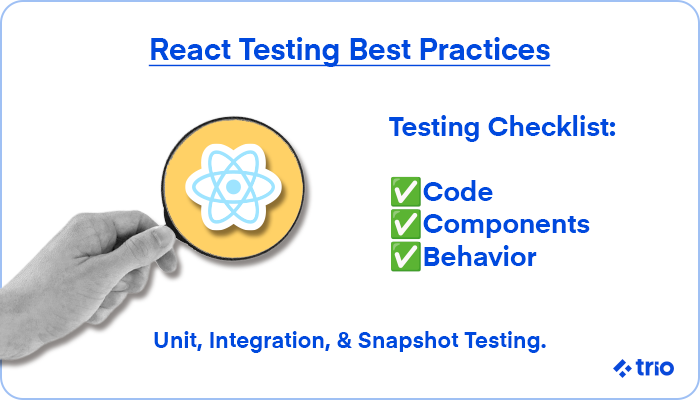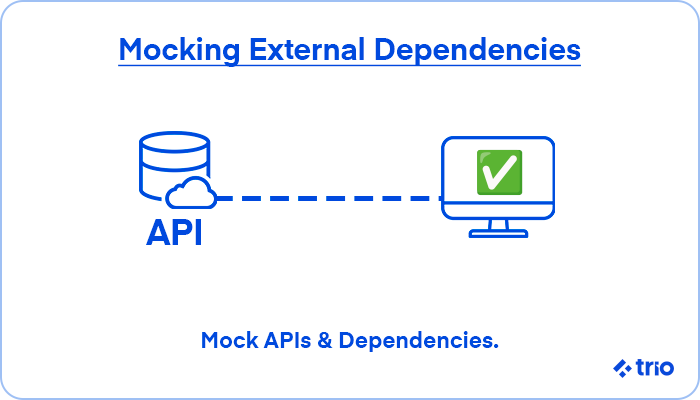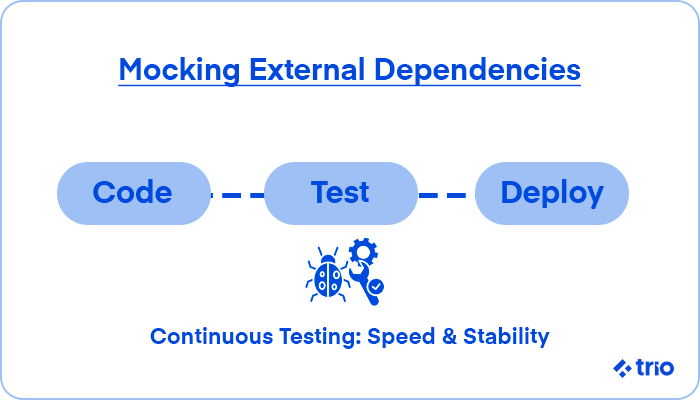Testing is one of the most important parts of any project. It’s how you make sure things are working! Your React projects are by no means an exception.
Apps are getting more complex with every passing year. New technology emerges, and user expectations do nothing but grow. If something goes wrong, it can be a big issue if you have lines and lines of code to sift through.
Luckily, some straightforward React UI testing helps our developers identify bugs early, prevent regressions, and ensure components behave as expected.
Let’s look at the different types of testing, testing React applications, as well as certain best practices that will increase your chances of success! We’ll cover everything from writing practical unit tests, integration tests, end-to-end testing (E2E), tackling common challenges, and ensuring high test coverage easily.
We’ll also cover some of our tool recommendations and how you can use them in your testing strategy so you can jump straight into UI testing, whether you are a beginner or a seasoned React developer. This includes Jest, React Testing Library (RTL), and Cypress.
If you need a React developer to help you run unit tests, reach out to us. We have several years of experience successfully connecting companies with developers.
Whether you require outsourcing, staff augmentation, or a dedicated team, our focus on retaining top developer talent through developer well-being has led to many successful collaborative software development projects.

Understanding React Testing
Before you can start writing your tests, you need to have some level of understanding of the different types of React testing out there. Let’s cover those basics, along with the tools that you will need in all of these scenarios.
Unit Testing
Unit tests, as you can gather from the name, focus on verifying the way that a single unit or component of your React app works. The idea is that you figure out which components have issues as you build them, allowing you to catch bugs early and ensure the core functionality of your app.
While this can be useful, there are upsides and downsides to testing your components in isolation.
We have found that it is almost impossible to focus on testing component behavior and implementation details using unit tests. So, our developers recommend not worrying about implementation at all.
For example, it’s more important to verify how a button component behaves when clicked rather than how it internally manages its state. This keeps your tests robust and less likely to break during refactoring, but it does mean that you are going to need more tests overall.
It’s best to make sure you use meaningful assertions when testing. In other words, your tests should measure real outcomes like rendered text, DOM changes, and even how your component handles events – what happens when the button is clicked. If you aren’t sure, ask yourself if users will be directly affected.
In these cases, you should make your tests small, focused, and cover specific responsibilities, ensuring that each test only validates one behavior. This makes debugging easier when failures occur, as it is clear what aspect of the component is malfunctioning.
Integration Testing
As we just mentioned, unit testing doesn’t consider integration with other features, so you’ll need to focus on separate integration testing to verify how your different components or modules work together, and if there is any room for improvement.
A good example in this case is verifying that a form input component is passing the data to a parent form handler the right way.
We recommend that you start testing with the most critical user flows, focusing on areas where different components depend on shared state, shared routing, or even shared context providers.
End-to-End (E2E Testing)
End-to-end testing is different from unit and integration testing in that it tests the whole application. This testing is done by simulating user behavior, so you get a better idea of how everything works as a whole, from the user’s perspective.
End-to-end testing will cover how submitting a form or clicking a button behaves across your whole tech stack, making sure it works as expected.
There are a couple of different tools that you can use to automate these interactions so that you can test workflows across different browsers, devices, and ecosystems.
React UI Testing Tools Overview
Now that you have a better idea of the different types of testing, let’s take a closer look at the tools that you can use to make the process easier. We’ll look at three of our developers’ recommendations: Jest, React Testing Library (RTL), and Cypress.
Jest
Jest serves as the backbone of React testing by offering a robust framework for writing and running tests.
As an out-of-the-box solution, Jest is widely used when people need to test because of its simplicity and ease of integration with React projects, especially when using Create React App, which is pre-configured.
Jest is mainly known for its support of snapshot testing, which allows our developers to capture and compare a component’s rendered output over time.
This feature is invaluable when tracking unexpected UI changes that might occur during development and affect your user experience later on.
Additionally, our developers use Jest for its extensive mocking capabilities, which make it easier to simulate external dependencies and ensure that your unit tests focus on the component logic without outside interference.
React Testing Library
The React Testing Library (RTL) is one of many testing tools that provide an effective way to test components by encouraging developers to focus on how users would interact with the application rather than how it is implemented.
RTL prioritizes testing through user-centric methods like interacting with the DOM via simulated clicks, key presses, or form submissions.
We’ve seen how this results in more maintainable tests that are less likely to break when refactoring the internal logic of components.
By using queries such as getByText or getByRole, RTL ensures that the tests mimic user behavior more closely, making them more reliable. This approach minimizes reliance on the internal component structure, so the tests end up being less brittle during refactoring.
Unlike older approaches that test specific tags or class names, RTL’s emphasis on public APIs ensures your components are tested in a way that mirrors real-world use.
Cypress
Cypress is an incredible end-to-end testing tool. Unlike the unit testing tool, Jest, Cypress can interact with your entire application.
One of the best parts of Cypress is its automation, with automatic clicking, navigating, form submission, and even waiting. The result is some powerful debugging, with the tool even being able to provide visual snapshots during test runs.
It’s a great way to make sure workflows function correctly before the initial release of your app.
Setting Up the Testing Environment
Configuring your testing environment will make sure that your React tests run smoothly. You need to get the right dependencies and tools from the start and make sure that you are organizing your project properly. Let’s walk you through how to do that.
Installing Necessary Dependencies
Setting up a React testing environment requires a few essential tools.
We have already mentioned how Jest acts as the primary test runner, helping manage and execute your tests, while you’ll need React Testing Library for rendering components in tests and simulating user interactions.
This is just the very basics, though. Next, you need to think about what you are using alongside React.
If your application uses modern JavaScript syntax (including JSX), you’ll need something like Babel, which can transpile your code into a format Jest can understand. If you are still in the early stages of development, you could also just use Create React App, which comes pre-configured.
Although Jest and React Testing Library are often sufficient for most React projects, make sure that you think about your individual situation and do your research beforehand so you can install all of the dependencies that you need.
Once you’ve made your selection, you can then install them.
To do this, run:
npm install –save-dev jest @testing-library/react @testing-library/jest-dom
Similarly, if you need to install Cyprus for E2E testing, you would go about it much the same way:
npm install –save-dev cypress
Configuring Jest and React Testing Library
Configuring Jest in a React project is a straightforward process, especially if you’re using Create React App, where it’s pre-configured.
For custom setups, installing Jest is as simple as running the installation command, followed by creating a configuration file.
This configuration file allows you to specify your test environment, typically jsdom for React apps, and any setup files you need for initialization.
For a custom setup, here’s an example of a basic Jest configuration (jest.config.js):
module.exports = {
testEnvironment: ‘jsdom’,
setupFilesAfterEnv: [‘./jest.setup.js’],
transform: {
‘^.+\\.(js|jsx)$’: ‘babel-jest’,
},
};
It’s also a good idea to create a separate file for the setup. Something like jest.setup.js will usually be suitable. This will let you include custom configurations. One thing we encounter is extending expect matchers with RTL, but the possibilities are vast.
Running tests is then easily managed through the terminal by using the npm test command, allowing for continuous feedback during development.
RTL needs very little configuration beyond the initial setup. It’s very much ‘plug-and-play’, but setting up a global import of its custom matchers will improve readability and test reliability, making it a much more pleasant experience.
If you are unsure about how to configure Jest as a test runner, you can rest assured that our developers have the necessary experience to do so correctly.
This experience is one of many ways that we focus on building trust in software partnerships here at Trio, as our clients can rest easy knowing they get the top 1% of talent when they come to us!
Organizing Test Files and Folders
We’ve already mentioned creating a separate file for setup, but it is even more essential that you effectively organize your test files. Doing so from the start will help you maintain clarity and scalability as your project grows and becomes more complicated.
A simple, user-friendly organization makes it easier for different people to navigate and update tests, and having some standards in place makes it easier to avoid duplication. It’s also easier for your CI/CD pipelines to find and run the tests, speeding up timelines a fair amount.
It is considered a pretty standard convention to place your test files alongside the components they test. Usually, you would use a suffix like .test.js or .spec.js.
For example, if you were working on a button, you could expect something like the following:
/components
/Button
Button.js
Button.test.js
If you wanted to, you could also add an entirely separate _tests_ directory to keep them isolated.
/components
/Button
Button.js
/tests
Button.test.js
A lot of developers also like to use describe blocks in their test files to group things together, which can really improve readability in large projects.
Writing Effective Unit Tests
Now you’re set up, how do you carry out the practical tests effectively in different scenarios? Let’s look at testing component rendering, simulating user interactions, and mocking external dependencies in your tests.
Testing Component Rendering
Practical unit tests focus on ensuring components function as expected under various conditions.
Remember, as we have already mentioned above, in these cases it is important to prioritize testing behavior over implementation details. The more focused you can get, the better the test will be.
For example, when testing a form input component, you may want to ensure a specific label is rendered, or that the input values update as you expect them to when your user types something in the form. Here’s what that might look like:
import { render, screen } from ‘@testing-library/react’;
import FormInput from ‘./FormInput’;
test(‘renders the input label correctly’, () => {
render();
expect(screen.getByText(/username/i)).toBeInTheDocument();
});
As you can see, the process is relatively simple, but it is important to get as specific as possible.
Simulating User Interactions
As we’ve mentioned above, a big part of effective testing is being able to simulate how users will actually interact with your website, as components often change state based on user inputs like clicks, form submissions, or keyboard events.
We have briefly discussed testing implementation using the React Testing Library. You can simulate these interactions with its fireEvent utility, or the much newer userEvent utilities, which work a little better at mimicking how users actually interact with the DOM.
Let’s look at the form example again, to see how this might look:
import { render, fireEvent, screen } from ‘@testing-library/react’;
import LoginForm from ‘./LoginForm’; // Assume this is a form component
test(‘handles form submission correctly’, () => {
const handleSubmit = jest.fn(); // Mock submit handler
render(<LoginForm onSubmit={handleSubmit} />);
// Simulate entering values into input fields
fireEvent.change(screen.getByLabelText(/username/i), { target: { value: ‘JohnDoe’ } });
fireEvent.change(screen.getByLabelText(/password/i), { target: { value: ‘password123’ } });
// Simulate clicking the submit button
fireEvent.click(screen.getByText(/submit/i));
// Ensure the submit handler was called with the correct data
expect(handleSubmit).toHaveBeenCalledWith({
username: ‘JohnDoe’,
password: ‘password123’,
});
// Ensure the form fields are cleared or reset after submission if applicable
expect(screen.getByLabelText(/username/i).value).toBe(”);
expect(screen.getByLabelText(/password/i).value).toBe(”);
});
Mocking External Dependencies
When testing React components, one of the most significant challenges we have seen people run into is dealing with external dependencies like APIs or third-party services.
Mocking these dependencies allows you to isolate the component’s logic and ensures tests are not affected by external factors such as network latency or API downtime.
Jest is again the way that we recommend you go, as it simplifies mocking by allowing you to create manual mocks for entire modules or mock individual functions within your test.
Here’s an example of how you can mock an API call using Jest:
import { render, screen, waitFor } from ‘@testing-library/react’;
import axios from ‘axios’;
import Users from ‘./Users’; // Assume this component fetches and displays users
// Mocking the axios module
jest.mock(‘axios’);
test(‘fetches and displays users’, async () => {
const users = [{ name: ‘John Doe’ }];
axios.get.mockResolvedValue({ data: users });
render(<Users />);
// Verify that the loading message appears
expect(screen.getByText(/loading/i)).toBeInTheDocument();
// Wait for the mock API call to resolve and users to appear
const userElement = await waitFor(() => screen.getByText(/john doe/i));
// Verify that the user data is displayed
expect(userElement).toBeInTheDocument();
});
This makes it easier to simulate various scenarios, such as successful or failed API calls, without requiring actual network requests.

Best Practices for React UI Testing
There are a couple of best practices that our developers like to keep in mind to create the most efficient tests possible:
- Focus on testing behavior over implementation details.
- Keep tests isolated and independent.
- Use descriptive test names.
- Maintain high test coverage without redundancy.
If you focus on the wrong stuff or your tests aren’t as specific as possible, finding any issues becomes difficult and time-consuming. Similarly, tests that cover the same thing waste your time.
You want to test as thoroughly as you can, without overtesting or causing further confusion. This usually comes with experience.
What Metrics Should You Track for Test Coverage?
Ensuring high test coverage in a React project requires monitoring specific metrics that give insights into how thoroughly your code is tested.
These metrics include statement coverage, which measures the percentage of code statements executed during tests, and branch coverage, which ensures all paths in conditional logic are covered.
Function coverage tracks whether all functions in your codebase are executed during testing.
These metrics help ensure that no significant areas of your application remain untested, giving you confidence that potential bugs are caught early.
How to Use Coverage Reports to Improve Tests?
Coverage reports generated by Jest provide an overview of which parts of your application are well-tested and which areas require more attention.
As we have already mentioned, by analyzing these reports, developers can identify gaps in testing and prioritize writing tests for critical, untested areas.
Additionally, coverage reports can be used to identify redundant tests, allowing teams to streamline their test suites and improve overall test performance.
Advanced Testing Techniques
Once you’ve got the basics covered, there are some advanced concepts you can start approaching in your React UI testing.
Snapshot Testing
Snapshot testing is a method that we have seen used to verify that a component’s rendered output remains consistent over time.
When you first run a snapshot test, Jest captures the current state of the component and saves it in a file. Subsequent tests compare the current output to this saved snapshot, flagging any differences.
This type of test is particularly useful for stable, static components where changes in structure could indicate a bug.
However, snapshots aren’t for everything. You should be using them really selectively, as they can become difficult to manage in large projects or when the UI is frequently updated.
Here’s what a basic snapshot might look like:
import { render } from ‘@testing-library/react’;
import Button from ‘./Button’;
import renderer from ‘react-test-renderer’;
test(‘renders correctly’, () => {
const tree = renderer.create().toJSON();
expect(tree).toMatchSnapshot();
});
Accessibility Testing
The world is focusing more on being accommodating to people who have some kind of disability, and web apps are no exception. Accessibility testing lets you check if you are being inclusive and compliant with accessibility standards.
One great tool designed specifically for this kind of testing is axe-core, which you can combine with RTL to detect accessibility (a11y) issues that are considered quite common.
Here’s what that might look like:
import { render } from ‘@testing-library/react’;
import { axe, toHaveNoViolations } from ‘jest-axe’;
import LoginForm from ‘./LoginForm’;
expect.extend(toHaveNoViolations);
test(‘LoginForm should have no accessibility violations’, async () => {
const { container } = render();
const results = await axe(container);
expect(results).toHaveNoViolations();
});
Performance Testing
Performance testing is a little different from unit and integration testing as it focuses more on speed, rather than general functionality.
They usually work by simulating real-world conditions and testing specific interaction patterns or component trees.
Here’s what you could expect:
import { render } from ‘@testing-library/react’;
import HeavyComponent from ‘./HeavyComponent’;
test(‘renders HeavyComponent within acceptable time’, () => {
const start = performance.now();
render();
const end = performance.now();
expect(end – start).toBeLessThan(200); // milliseconds threshold
});
Continuous Integration and Testing
Continuous testing is the practice of running automated tests throughout the development process, allowing for immediate feedback on code changes.
In React apps, continuous testing offers several key benefits.
One of the primary advantages is the early detection of bugs. By integrating tests into the CI/CD pipeline, developers can catch issues at the early stages of development, before they become more complex and costly to fix.
This proactive approach reduces the likelihood of bugs making it into production, resulting in a more reliable application.
Continuous testing also improves code quality. Since tests are automatically executed whenever changes are made, it ensures that each new feature or update doesn’t introduce regressions.
This leads to a more stable codebase and helps developers maintain a high standard of quality across the entire project.
In terms of team productivity, continuous testing allows developers to focus on writing new code rather than manually verifying existing functionality.
This automation speeds up the development process, as bugs can be identified and resolved quickly without slowing down the pace of new feature development.
Moreover, automated tests provide the confidence to make large-scale changes, as the test suite guarantees that the rest of the app remains unaffected.
Finally, continuous testing is essential for faster release cycles. Automated tests reduce the need for lengthy manual testing sessions, allowing teams to deploy more frequently and with greater confidence.
This is particularly beneficial in agile environments where rapid iteration and deployment are key to staying competitive.

If you focus on these sustainable software development practices, not only will you immediately save money through cost-effective development, but you will also save money by keeping developers happier and retaining them longer.
The result is that you know your developer is a good team culture fit, and they have relatively good satisfaction and performance.
What are the Future Trends in React Testing?
How is Testing Evolving with New React Features?
As React continues to introduce new features like Concurrent Mode and Suspense, testing strategies must evolve to account for these changes.
Testing for Concurrent Mode, for example, requires ensuring that UI updates are non-blocking and behave as expected even during concurrent rendering.
Tools like React Testing Library have adapted to handle these features, but developers need to stay updated on sustainable software development best practices for testing modern React functionalities.
What Innovations are Emerging in Testing Frameworks?
The landscape of testing frameworks is constantly evolving, with new tools and features emerging to make testing faster, more efficient, and better suited to modern development workflows.
One of the most significant innovations is the rise of faster test runners like Vitest, which are designed to be quicker and more lightweight compared to traditional options like Jest.
These test runners are gaining popularity due to their reduced setup time and faster test execution, making them ideal for large codebases and projects requiring quick feedback.
Another exciting trend is the growing use of visual regression testing. Tools like Chromatic allow developers to catch UI bugs by comparing screenshots of rendered components before and after code changes.
This method helps ensure that even subtle visual discrepancies, which may not be caught by traditional unit or functional tests, are identified and addressed early on.
This approach is particularly useful for React apps with dynamic UIs, where visual consistency is critical.
Additionally, improved debugging tools are becoming more prevalent in modern testing frameworks.
Newer versions of frameworks such as Jest and Vitest offer enhanced error messages and debugging features that make it easier for developers to trace failing tests back to the exact line of code that caused the issue.
These innovations significantly reduce the time spent hunting for the root cause of failures, improving developer productivity.
Lastly, there’s an increasing focus on cross-browser testing automation, with tools like Cypress and Playwright leading the charge.
These frameworks allow developers to test their React apps across multiple browsers with ease, ensuring consistent behavior regardless of the platform.
Cross-browser testing has become more crucial as users access apps on an ever-expanding array of devices and browsers, and these modern frameworks are designed to meet that demand efficiently.
How to Stay Updated on Best Practices for Testing?
As React continues to evolve, staying current with best practices for testing is crucial for maintaining an efficient and reliable codebase.
If you want to become a React developer or are one already, we would recommend regularly visiting the official React blog, which provides valuable insights into new features and changes that may affect testing strategies.
Engaging with the React community is another great way to stay informed.
By participating in discussions on platforms like GitHub, Stack Overflow, and social media, you can learn about the latest trends and solutions to common testing challenges.
It’s also helpful to follow trusted online resources such as Dev.to and Smashing Magazine, which frequently publish detailed articles and guides on best practices for React testing.
Attending webinars, conferences, or meetups like ReactConf will not only provide a deeper understanding of evolving testing strategies but also allow you to connect with other developers facing similar challenges.
The future of React testing continues to evolve with the introduction of new features like Concurrent Mode and innovations in testing frameworks.
Keeping up to date with these changes will help you adapt your testing strategies and ensure that your applications are always functioning as expected.
At Trio, we specialize in helping businesses connect with experienced developers who can both develop and test React applications efficiently.
Whether you need to outsource development, build a dedicated testing team, or augment your current staff, Trio offers expert services tailored to your needs.
Let us help you create reliable, scalable applications through streamlined testing practices and a keen focus on quality.
Contact us to set up a call and get you started on your collaborative software development journey.






